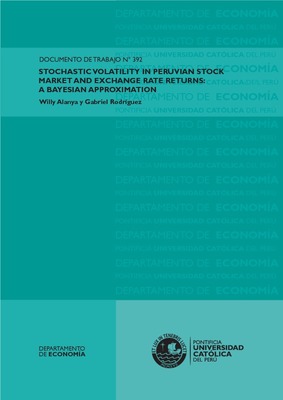| dc.contributor.author | Alanya, Willy | |
| dc.contributor.author | Rodríguez, Gabriel | |
| dc.date.accessioned | 2015-03-19T20:37:58Z | |
| dc.date.available | 2015-03-19T20:37:58Z | |
| dc.date.issued | 2014 | |
| dc.identifier.uri | http://repositorio.pucp.edu.pe/index/handle/123456789/47032 | |
| dc.description.abstract | Este estudio es uno de los primeros en utilizar el modelo SV para modelar series financieras peruanas, así como estimar y comparar con los modelos GARCH con errores normales y t-student. El análisis en este estudio corresponde a los mercados bursátiles y cambiarias de Perú. La importancia de esta metodología es que el ajuste de los datos es mejor que los modelos GARCH utilizando los supuestos de normalidad en ambos modelos. En el caso del modelo SV, se han empleado tres algoritmos Bayesianos donde evaluamos sus respectivas ineficiencias en la estimación de los parámetros del modelo siendo el algoritmo más eficiente y utilizado el Integration Sampler. Los parámetros estimados en el modelo SV muestran que los diversos algoritmos son consistentes, ya que muestran poco ineficiencia. Las cifras de las correlaciones de las iteraciones sugieren que no hay problemas en el momento del encadenamiento de las Cadenas de Markov en todas las estimaciones. Encontramos que las volatilidades en el mercado cambiario y la volatilidad del mercado bursátil siguen patrones similares en el tiempo. Es decir, cuando una turbulencia económica causada por las circunstancias económicas se produce, por ejemplo, la crisis asiática y la reciente crisis en los Estados Unidos, entonces la volatilidad se percibe en ambos mercados. | es_ES |
| dc.description.abstract | This study is one of the first to utilize the SV model to model Peruvian financial series, as well as estimating and comparing with GARCH models with normal and t-student errors. The analysis in this study corresponds to Peru s stock market and exchange rate returns. The importance of this methodology is that the adjustment of the data is better than the GARCH models using the assumptions of normality in both models. In the case of the SV model, three Bayesian algorithms have been employed where we evaluate their respective inefficiencies in the estimation of the model’s parameters being the most efficient the Integration sampler. The estimated parameters in the SV model under the various algorithms are consistent, as they display little inefficiency. The Figures of the correlations of the iterations suggest that there are no problems at the time of Markov chaining in all estimations. We find that the volatilities in exchange rate and stock market volatilities follow similar patterns over time. That is, when economic turbulence caused by the economic circumstances occurs, for example, the Asian crisis and the recent crisis in the United States, considerable volatility was generated in both markets. | en_US |
| dc.language.iso | spa | es_ES |
| dc.publisher | Pontificia Universidad Católica del Perú. Departamento de Economía | es_ES |
| dc.relation.ispartof | urn:issn:2079-8466 | |
| dc.relation.ispartof | urn:issn:2079-8474 | |
| dc.relation.ispartofseries | Documento de Trabajo;392 | es_ES |
| dc.rights | info:eu-repo/semantics/openAccess | es_ES |
| dc.rights.uri | http://creativecommons.org/licenses/by-nc-nd/2.5/pe/ | * |
| dc.subject | Modelo de volatilidad estocástica | es_ES |
| dc.subject | Estimación bayesiana | es_ES |
| dc.subject | Gibbs Sampler | es_ES |
| dc.subject | Mixture sampler | es_ES |
| dc.subject | Integration sampler | es_ES |
| dc.subject | Mercado bursátil | es_ES |
| dc.subject | Mercado cambiario | es_ES |
| dc.subject | Modelos GARCH | es_ES |
| dc.title | Stochastic Volatility in Peruvian Stock Market and Exchange Rate Returns: a Bayesian Approximation | es_ES |
| dc.title.alternative | Volatilidad Estocástica en los Retornos Bursátiles y Cambiarios en el Perú: Una Aproximación Bayesiana | es_ES |
| dc.type | info:eu-repo/semantics/workingPaper | |
| dc.type.other | Documento de trabajo | |
| dc.subject.ocde | http://purl.org/pe-repo/ocde/ford#5.02.00 | |
| dc.publisher.country | PE | |
| renati.advisor.orcid | https://orcid.org/0000-0003-1174-9642 | |


